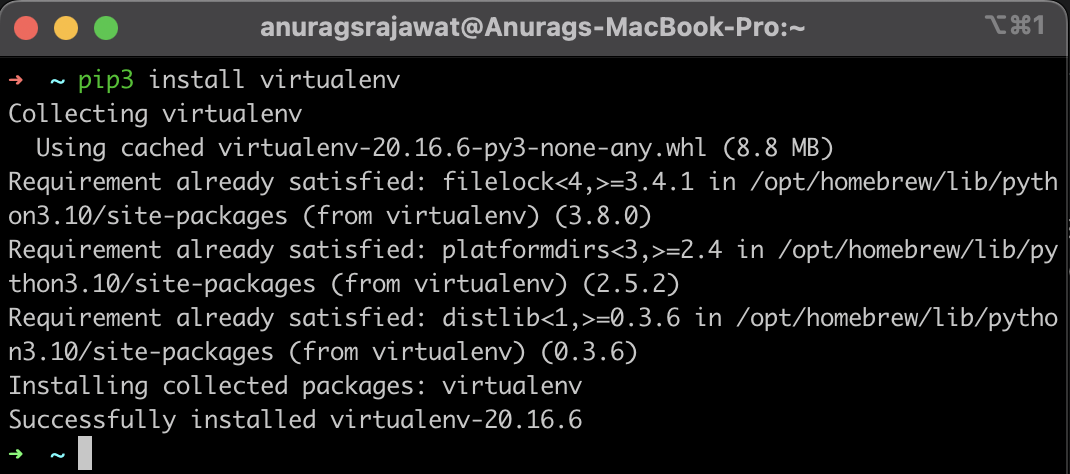Deactivate or Exit a Python Virtual Environment
Learn how to properly deactivate your Python virtual environment and return to your system's default Python interpreter with this quick and easy guide.
Learn how to properly deactivate your Python virtual environment and return to your system's default Python interpreter with this quick and easy guide.
This short guide will show you how to deactivate a Python virtual environment and return to your system's default Python environment.
To deactivate a Python virtual environment, you simply need to use the deactivate command in your terminal or command prompt.
Make sure you're in the virtual environment's directory before running the command. If you're unsure, typing which python will show you the path of the currently active Python interpreter, indicating whether you're in a virtual environment.
Once you run deactivate, your terminal prompt will return to its normal state, and you'll be back to your system's default Python environment.
This code snippet demonstrates how to check if you are in a Python virtual environment and how to deactivate it. It uses the 'which python' command to show the active Python interpreter before and after deactivating the environment using the 'deactivate' command.
# First, check if you're in a virtual environment
which python
# If the output shows a path within your virtual environment directory,
# you're good to go. For example:
# /home/user/my_project/env/bin/python
# Deactivate the virtual environment
deactivate
# Check again to confirm you're back to the system's Python
which python
# The output should now show the system's Python path, for example:
# /usr/bin/pythonExplanation:
which python (Before deactivation): This command helps you verify if you are currently within a virtual environment. If you are, it will display the path to the Python interpreter within your virtual environment's directory.deactivate: This is the core command to deactivate the virtual environment. It removes the environment's settings from your current shell session.which python (After deactivation): Running this command again after deactivate confirms that you are no longer in the virtual environment. The output will now show the path to your system's default Python interpreter.Important Note: The deactivate command is specific to virtual environments created using the venv or virtualenv modules in Python.
Why deactivate? Deactivating a virtual environment is crucial when you want to work on other projects or use your system's default Python installation. It prevents conflicts between packages and ensures you're working with the correct versions.
No special privileges: You don't need administrator or root privileges to deactivate a virtual environment. It's a simple command that can be executed by any user.
Shell-specific: Deactivation is specific to your current terminal session. Opening a new terminal window or tab will not inherit the virtual environment settings.
Alternatives to venv and virtualenv: If you're using a different virtual environment manager like conda or poetry, the deactivation process might differ. Refer to their respective documentation for specific instructions.
Troubleshooting: If you encounter issues with deactivate, double-check that you're inside the correct virtual environment directory. You can try activating the environment again and then deactivating it.
Best Practices: It's good practice to deactivate virtual environments when you're done using them. This keeps your development environment clean and organized.
| Action | Details |
|---|---|
| Command: | deactivate |
| Location: | Run within the virtual environment's directory. |
| Verification: | Use which python to check if you're in the virtual environment. The output will show the path of the active Python interpreter. |
| Result: | Your terminal prompt returns to its normal state, indicating you're back to the system's default Python environment. |
In conclusion, deactivating a Python virtual environment is a simple yet crucial step in managing your Python projects. Using the deactivate command within your virtual environment's directory returns you to your system's default Python environment, ensuring a clean and organized development workspace. Remember to verify your environment status with which python before and after deactivation. While this guide focused on venv and virtualenv, always consult the documentation for specific instructions if you're using alternative environment managers. By adhering to these practices, you can maintain a streamlined workflow and prevent conflicts in your Python development endeavors.
 How to leave/exit/deactivate a Python virtualenv - GeeksforGeeks | A Computer Science portal for geeks. It contains well written, well thought and well explained computer science and programming articles, quizzes and practice/competitive programming/company interview Questions.
How to leave/exit/deactivate a Python virtualenv - GeeksforGeeks | A Computer Science portal for geeks. It contains well written, well thought and well explained computer science and programming articles, quizzes and practice/competitive programming/company interview Questions. How To Exit/Deactivate a Python Virtualenv | Learn how to leave, exit, or deactivate a Python virtualenv in a simple and straightforward way.
How To Exit/Deactivate a Python Virtualenv | Learn how to leave, exit, or deactivate a Python virtualenv in a simple and straightforward way. Here is how to exit/deactivate a virtualenv in Python | To deactivate a virtual environment in Python, you can use the deactivate command. This is a shell command, not a Python command, so you'll need to run it from ...
Here is how to exit/deactivate a virtualenv in Python | To deactivate a virtual environment in Python, you can use the deactivate command. This is a shell command, not a Python command, so you'll need to run it from ... How to leave/exit/deactivate a Python virtualenv? | Better Stack ... | Better Stack lets you see inside any stack, debug any issue, and resolve any incident.
How to leave/exit/deactivate a Python virtualenv? | Better Stack ... | Better Stack lets you see inside any stack, debug any issue, and resolve any incident. How to leave/exit/deactivate a Python virtualenv? | Wyzant Ask An ... | May 24, 2019 ... Just call workon environment_name to activate your environment, and call deactivate to deactivate it.
How to leave/exit/deactivate a Python virtualenv? | Wyzant Ask An ... | May 24, 2019 ... Just call workon environment_name to activate your environment, and call deactivate to deactivate it.